Do you want to start grocery store business plan?
If you are planning to start a gourmet food store business, you can rest assured that it is a wise decision on your part. Starting this business is not only easy but also profitable as well. However, to make this venture a success, you must first have to prepare a comprehensive gourmet food store business plan.
The gourmet food store business plan will provide you a roadmap to follow and will also guide you through all your major decisions. To help you do this, we are providing the business plan of gourmet food startup named Foody Stop.
Executive Summary
If you are looking to make a business plan for a grocery store, this executive summary sample for food business as well as the business plan that follows can help you a lot.
2.1 The Business
Located in the serene environment of 11th Avenue, Boston, Foody Stop will be a one-stop service for all the food-related needs of our customers. Our location is almost ideal for starting a specialty food store. As a bonded and licensed food store business, we will provide high-quality food products to our customers.
The business will be owned by Keith Jim who has been associated with the food and gourmet food store business plans for the last 10 years. Owing to his extensive experience, Jim knows everything about how to start a specialty food store and make it successful.
2.2 Management
The business will be managed by Jim, who will be helped a group of dedicated workers. The store will function 24/7 and will be run by three shifts of workers. All employees will be recruited on merit and will be trained for one month before they start working.
2.3 Customers
Food Stop will provide an assortment of services to the residential community as well as working class people and visitors. The diversity of our offerings will be our major competitive advantages. From meat products to canned foods, dairy products to baking goods, we will provide almost all food products that our customers might need.
2.4 Target of the Company
Our business targets are as follows:
- To become the best food store in Boston by next three years
- To achieve the net profit margin of $10k per month by the first year, $15k by the second year, and $25k by the third year
- To balance the initial cost of the startup with earned profits within six months
- To start two more stores by the end of our second years
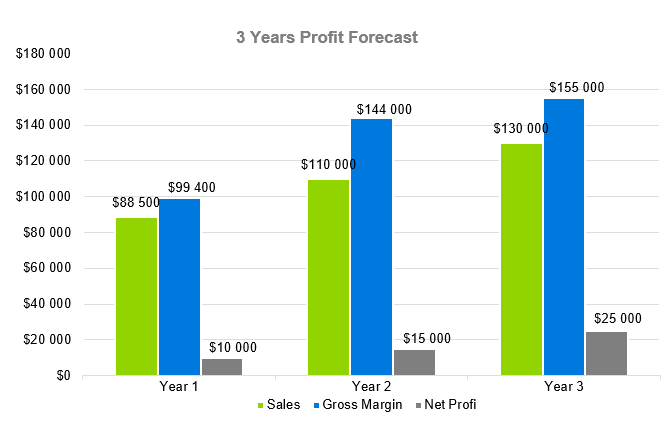
Company Summary
3.1 Company Owner
Foody Stop will be owned by Keith Jim, who is an MBA from Harvard. Jim has served in the food and retail industry for the last 10 years in an assortment of positions. Known for his sharp business acumen and incredible management skills, Jim has both the experience and the knowledge needed for starting a gourmet food store.
3.2 Why the Business is being started
The business will serve as a gateway to Jim for making it big in the food retail industry. Foody Stop is being started not only for profit generation but also for providing best-in-class services to customers.
3.3 How the Business will be started
Located in the serene environment of 11th Avenue, Boston, Foody Stop will be a one-stop service. A newly constructed shop spanning an area of 750 square feet will be acquired on lease for the business. Jim will seek the services of a local contracting firm for all the woodwork and furniture of the shop. The shop will function 24/7 and will be operated by workers in three shifts. The startup costs in accordance with the gourmet food store business plan as forecasted by the financial experts are as follows:
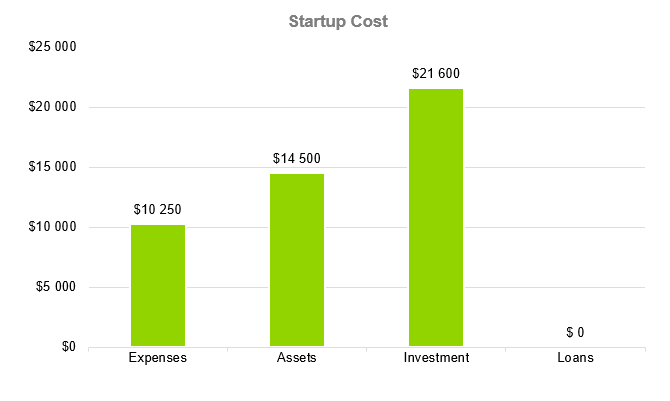
The detailed startup requirements, as forecasted by experts, is given below:
| Start-up Expenses | |
| Legal | $55,300 |
| Consultants | $0 |
| Insurance | $32,750 |
| Rent | $32,500 |
| Research and Development | $32,750 |
| Expensed Equipment | $32,750 |
| Signs | $1,250 |
| TOTAL START-UP EXPENSES | $187,300 |
| Start-up Assets | $0 |
| Cash Required | $332,500 |
| Start-up Inventory | $32,625 |
| Other Current Assets | $232,500 |
| Long-term Assets | $235,000 |
| TOTAL ASSETS | $121,875 |
| Total Requirements | $245,000 |
| START-UP FUNDING | $0 |
| START-UP FUNDING | $273,125 |
| Start-up Expenses to Fund | $11,875 |
| Start-up Assets to Fund | $15,000 |
| TOTAL FUNDING REQUIRED | $0 |
| Assets | $23,125 |
| Non-cash Assets from Start-up | $18,750 |
| Cash Requirements from Start-up | $0 |
| Additional Cash Raised | $18,750 |
| Cash Balance on Starting Date | $21,875 |
| TOTAL ASSETS | $0 |
| Liabilities and Capital | $0 |
| Liabilities | $0 |
| Current Borrowing | $0 |
| Long-term Liabilities | $0 |
| Accounts Payable (Outstanding Bills) | $0 |
| Other Current Liabilities (interest-free) | $0 |
| TOTAL LIABILITIES | $0 |
| Capital | $0 |
| Planned Investment | $0 |
| Investor 1 | $332,500 |
| Investor 2 | $0 |
| Other | $0 |
| Additional Investment Requirement | $0 |
| TOTAL PLANNED INVESTMENT | $695,000 |
| Loss at Start-up (Start-up Expenses) | $313,125 |
| TOTAL CAPITAL | $251,875 |
| TOTAL CAPITAL AND LIABILITIES | $251,875 |
| Total Funding | $255,000 |
Services
Food Stop will provide an assortment of services, as highlighted by our mini grocery store business plan. The diversity of our offerings will be our major competitive advantages over other gourmet food stores in the area. From meat products to canned foods, dairy products to baking goods, we will provide everything that our customers might need.
Listing your offerings and services in a general store business plan guides your other major decisions that’s why it must be done before you think about how to open a gourmet food store . According to Jim’s mini market business plan, Foody Stop will provide the following products and offerings:
- Meat and produce: poultry, beef, lunch meat, pork, fruits, vegetables, and more.
- Baking goods and bakery products: sandwich loaves, tortillas, bagels, dinner rolls, cereals, pasta, mixes, flour, sugar, and more.
- Frozen foods and beverages: waffles, vegetables, individual meals, ice cream, coffee, tea, juice, soda, drinks, and more.
- Dairy products and canned goods: cheese, eggs, milk, yogurt, butter, vegetables, spaghetti sauce, ketchup, and more.
We will offer food products of both local and international brands. We will make sure to keep our products like meat and vegetables as fresh as possible. Our food products will meet all standards set by food authorities. Also, we will provide our offerings in standard packaging sizes.
Marketing Analysis of Grocery Business
The most important component of an effective mini grocery store business plan is its accurate marketing analysis that’s why Jim acquired the services of marketing experts to help him through this phase. It is only after this stage that a good food stall business plan could have been developed. After identifying the local market trends in Boston, the marketing experts also guided him to select the best location for his food store. Marketing analysis is a must-do thing before you even think about how to start a gourmet food business.
5.1 Market Trends
The gourmet food industry has been constantly expanding in the US for the last several decades. According to 2016 figures, the US convenience store industry stood at $680 billion. Out of this astronomical figure, around 21.4% of the amount was generated by the sale of food products. Moreover, analysts have predicted a constant growth of this sector for many decades to come. Considering these trends, it is evident that the grocery food business is an immensely profitable niche.
5.2 Marketing Segmentation
In order to make an effective food retail business plan, it is crucial to analyze the market segmentation of your potential customers. Our marketing analysts have identified the following type of target audience which can become our future consumers:
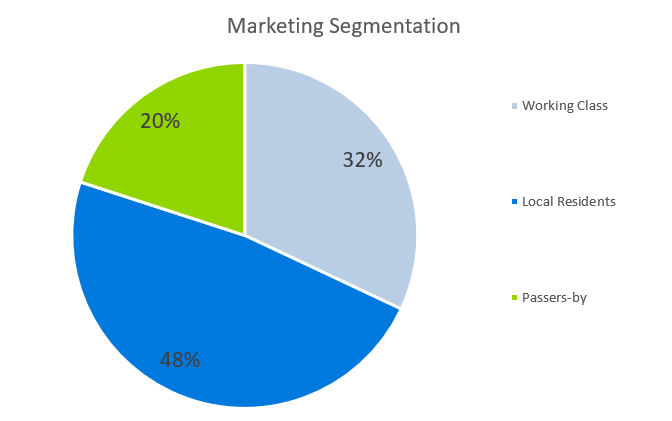
The detailed marketing segmentation of our target audience, as per our food market business plan, is as follows:
5.2.1 Local Residents: The community residing near our food store will be the primary customer group of our business. We will devise special plans to target this potential group as we expect a lot of sales to happen through them.
5.2.2 Working Class: Our second category of customers include those people whose busy routine makes them rely on packed foods. Our ready-made, packed foods will be a feasible option for the working-class people to have lunch without missing on their important work.
5.2.3 Passers-by: The third group includes those people who are in the area for some specific purpose. Our food store will provide a perfect spot for them to rest for a while and grab a drink or something.
The detailed market analysis of our potential customers is given in the following table:
| Market Analysis | |||||||
| Potential Customers | Growth | Year 1 | Year 2 | Year 3 | Year 4 | Year 5 | CAGR |
| Working Class | 32% | 11,433 | 13,344 | 16,553 | 18,745 | 20,545 | 13.43% |
| Local Residents | 48% | 22,334 | 32,344 | 43,665 | 52,544 | 66,432 | 10.00% |
| Passers-by | 20% | 12,867 | 14,433 | 15,999 | 17,565 | 19,131 | 15.32% |
| Total | 100% | 46,634 | 60,121 | 76,217 | 88,854 | 106,108 | 9.54% |
5.3 Business Target
We aim to become the best gourmet food store in Boston within the next three years of our startup. This could be achieved by providing high-quality products and winning the trust of our customers. Our primary business targets could be summed up as follows:
- To achieve the net profit margin of $10k per month by the end of the first year, $15k per month by the end of the second year, and $25k per month by the end of the third year
- To balance the initial cost of the startup with earned profits within six months
- To start two more stores by the end of our second years
5.4 Product Pricing
After considering the current market prices offered by our competitors, we have priced all our products in similar ranges as of them. We have to attract customers while yielding a profit at the same time that’s why we can’t afford to lower our prices at the moment, especially when we will offer incredibly high-quality food products.
Strategy
Like the marketing plan for a grocery store, sales strategy is also an important component of your gourmet food store business plan. After you have identified the market trends, market demand, and potential customers of the gourmet business, you will next have to plan a creative sales strategy to attract your target audience toward you and convert them into loyal customers.
After carrying out extensive research about successful advertising strategies that are being used by other similar business, Jim came up with brilliant ideas to attract customers and generate sales. Our sales strategy, as highlighted by our produce store business plan is as follows:
6.1 Competitive Analysis
Before finalizing your sales strategy, it is crucial for you to find out your competitive advantage over other similar businesses and make them a part of your business plan on supermarket . Considering the current market situation, Foody Stop will face really tough competition. However, we will soon emerge as a leading food store due to our numerous competitive advantages.
We will be open 24/7 and provide diverse offerings as a one-stop service provider. We will ensure that our goods meet all quality standards and are always available in a fresh state. Moreover, we will exceptional customer service to turn our visitors into loyal customers.
6.2 Sales Strategy
Following are some of the brilliant ideas by which we will advertise ourselves and generate sales.
- We will conduct a large-scale Facebook and Instagram marketing campaign for our advertisement.
- We will offer gifts and discounts on all our products for the entire first month to encourage sales.
- We will issue referral cards to our loyal customers and offer special discounts on customer referrals.
6.3 Sales Forecast
Considering our sales strategy and the current market demand for our business, our sales pattern is expected to increase with years. By analyzing our market segmentation strategy for the business, our forecasted sales on a yearly basis are summarized in the following column charts.
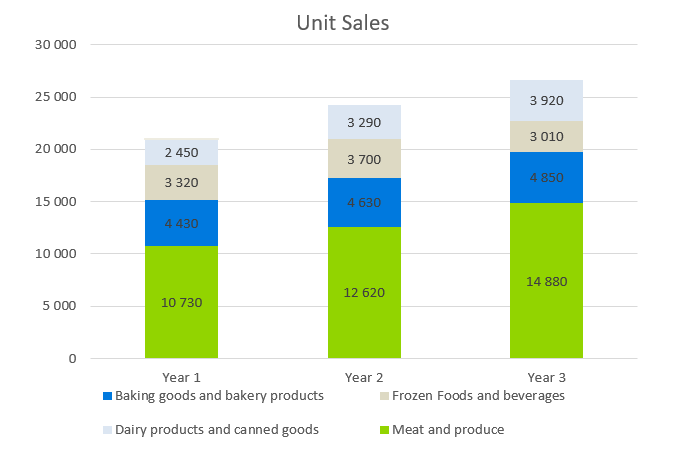
The detailed information about sales forecast, total unit sales, total sales is given in the following table.
| Sales Forecast | |||
| Unit Sales | Year 1 | Year 2 | Year 3 |
| Meat and produce | 1,887,030 | 2,680,320 | 2,588,240 |
| Baking goods and bakery products | 802,370 | 815,430 | 823,540 |
| Frozen Foods and beverages | 539,320 | 770230 | 1,002,310 |
| Dairy products and canned goods | 265,450 | 322,390 | 393,320 |
| TOTAL UNIT SALES | 3,494,170 | 4,588,370 | 4,807,410 |
| Unit Prices | Year 1 | Year 2 | Year 3 |
| Meat and produce | $140.00 | $150.00 | $160.00 |
| Baking goods and bakery products | $600.00 | $800.00 | $1,000.00 |
| Frozen Foods and beverages | $700.00 | $800.00 | $900.00 |
| Dairy products and canned goods | $650.00 | $750.00 | $850.00 |
| Sales | |||
| Meat and produce | $2,149,800 | $2,784,000 | $3,383,200 |
| Baking goods and bakery products | $120,050 | $194,500 | $268,500 |
| Frozen Foods and beverages | $50,110 | $71,600 | $93,000 |
| Dairy products and canned goods | $139,350 | $194,600 | $249,850 |
| TOTAL SALES | |||
| Direct Unit Costs | Year 1 | Year 2 | Year 3 |
| Meat and produce | $0.70 | $0.80 | $0.90 |
| Baking goods and bakery products | $0.40 | $0.45 | $0.50 |
| Frozen Foods and beverages | $0.30 | $0.35 | $0.40 |
| Dairy products and canned goods | $3.00 | $3.50 | $4.00 |
| Direct Cost of Sales | |||
| Meat and produce | $989,300 | $1,839,000 | $2,679,700 |
| Baking goods and bakery products | $66,600 | $119,900 | $173,200 |
| Frozen Foods and beverages | $17,900 | $35,000 | $52,100 |
| Dairy products and canned goods | $19,400 | $67,600 | $115,800 |
| Subtotal Direct Cost of Sales | $1,294,100 | $1,699,400 | $2,104,700 |
6.4 Sales Monthly
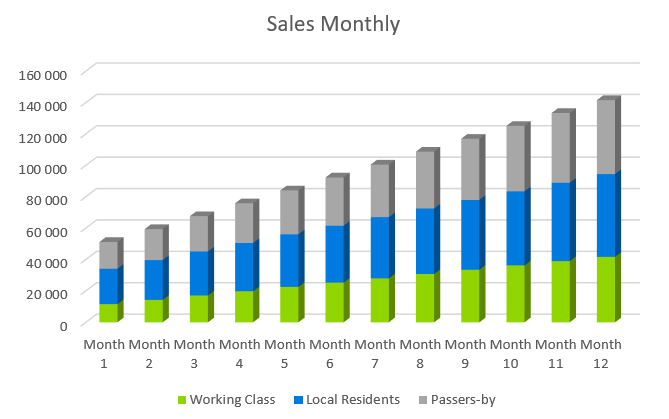
6.5 Sales Yearly
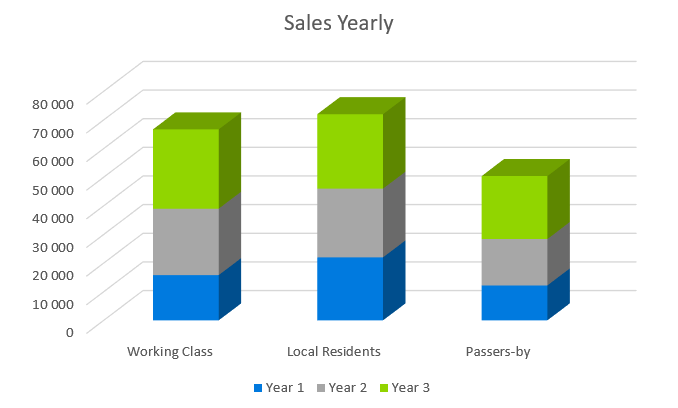
Personnel plan
Before starting a gourmet food store business plan, it is essential to estimate the number and type of employees required. Our personnel plan, as developed with the help of HR experts is as follows:
7.1 Company Staff
Jim will act as the General Manager of the company and will hire the following people:
- 1 Store Manager for managing the store operations
- 2 Administrators/ Accountants for maintaining financial records
- 2 Sales Executives for marketing purposes
- 10 Employees for running the store
- 2 Inventory Manager for managing the merchandise
- 1 Supply Chain Manager for purchasing food products
- 3 Drivers for transporting products from storage to store
- 2 Cleaners for keeping the store clean
- 1 Front Desk Officer for providing information to customers
- 2 Security Officers
7.2 Average Salary of Employees
The forecasted data about employees’ salaries for the next three years is given in the following table.
| Personnel Plan | |||
| Year 1 | Year 2 | Year 3 | |
| Store Manager | $85,000 | $95,000 | $105,000 |
| Administrators / Accountants | $45,000 | $52,000 | $59,000 |
| Sales Executives | $85,000 | $92,000 | $109,000 |
| Employees | $410,000 | $440,000 | $480,000 |
| Inventory Managers | $66,000 | $73,000 | $80,000 |
| Supply Chain Manager | $35,000 | $42,000 | $59,000 |
| Drivers | $60,000 | $63,300 | $70,000 |
| Cleaners | $63,300 | $70,000 | $76,700 |
| Front Desk Officer | $20,000 | $23,300 | $30,000 |
| Security Officers | $40,000 | $45,000 | $52,000 |
| Total Salaries | $784,300 | $855,600 | $963,700 |
Financial Plan
A financial plan is the final component of your grocery store business plan. It addresses all the costs and expenses which will be required for the startup. From the cost of inventory to your rent, from the overhead expenses to the cost of bills, it will address each and every financial component of your departmental store business plan. The financial plan of Foody Stop is as follows:
8.1 Important Assumptions
| General Assumptions | |||
| Year 1 | Year 2 | Year 3 | |
| Plan Month | 1 | 2 | 3 |
| Current Interest Rate | 10.00% | 11.00% | 12.00% |
| Long-term Interest Rate | 10.00% | 10.00% | 10.00% |
| Tax Rate | 26.42% | 27.76% | 28.12% |
| Other | 0 | 0 | 0 |
8.2 Brake-even Analysis
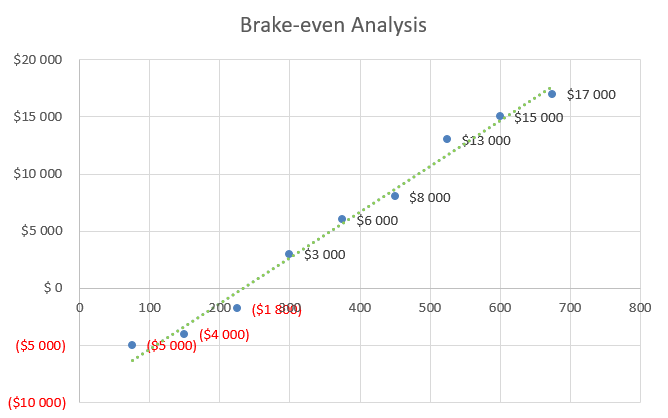
| Brake-Even Analysis | |
| Monthly Units Break-even | 5530 |
| Monthly Revenue Break-even | $159,740 |
| Assumptions: | |
| Average Per-Unit Revenue | $260.87 |
| Average Per-Unit Variable Cost | $0.89 |
| Estimated Monthly Fixed Cost | $196,410 |
8.3 Projected Profit and Loss
| Pro Forma Profit And Loss | |||
| Year 1 | Year 2 | Year 3 | |
| Sales | $309,069 | $385,934 | $462,799 |
| Direct Cost of Sales | $15,100 | $19,153 | $23,206 |
| Other | $0 | $0 | $0 |
| TOTAL COST OF SALES | $15,100 | $19,153 | $23,206 |
| Gross Margin | $293,969 | $366,781 | $439,593 |
| Gross Margin % | 94.98% | 94.72% | 94.46% |
| Expenses | |||
| Payroll | $138,036 | $162,898 | $187,760 |
| Sales and Marketing and Other Expenses | $1,850 | $2,000 | $2,150 |
| Depreciation | $2,070 | $2,070 | $2,070 |
| Leased Equipment | $0 | $0 | $0 |
| Utilities | $4,000 | $4,250 | $4,500 |
| Insurance | $1,800 | $1,800 | $1,800 |
| Rent | $6,500 | $7,000 | $7,500 |
| Payroll Taxes | $34,510 | $40,726 | $46,942 |
| Other | $0 | $0 | $0 |
| Total Operating Expenses | $188,766 | $220,744 | $252,722 |
| Profit Before Interest and Taxes | $105,205 | $146,040 | $186,875 |
| EBITDA | $107,275 | $148,110 | $188,945 |
| Interest Expense | $0 | $0 | $0 |
| Taxes Incurred | $26,838 | $37,315 | $47,792 |
| Net Profit | $78,367 | $108,725 | $139,083 |
| Net Profit/Sales | 30.00% | 39.32% | 48.64% |
8.3.1 Profit Monthly
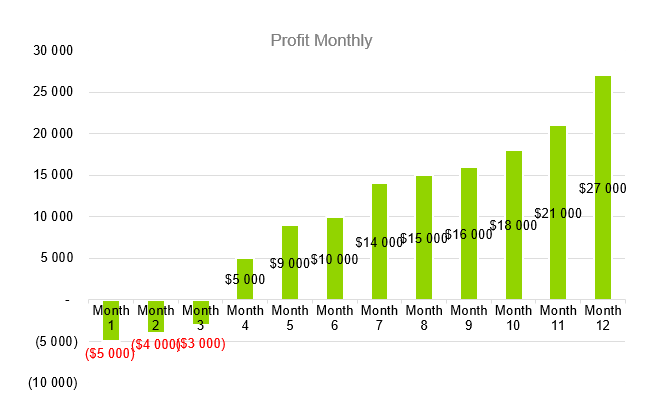
8.3.2 Profit Yearly
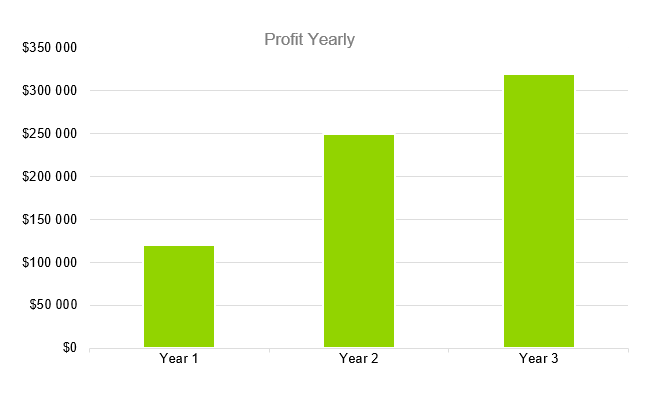
8.3.3 Gross Margin Monthly
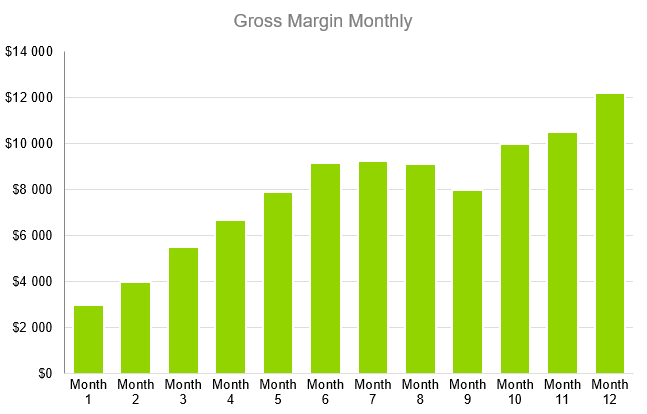
8.3.4 Gross Margin Yearly
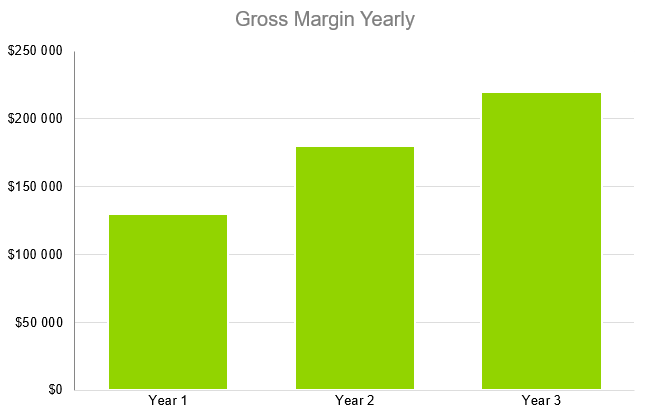
8.4 Projected Cash Flow
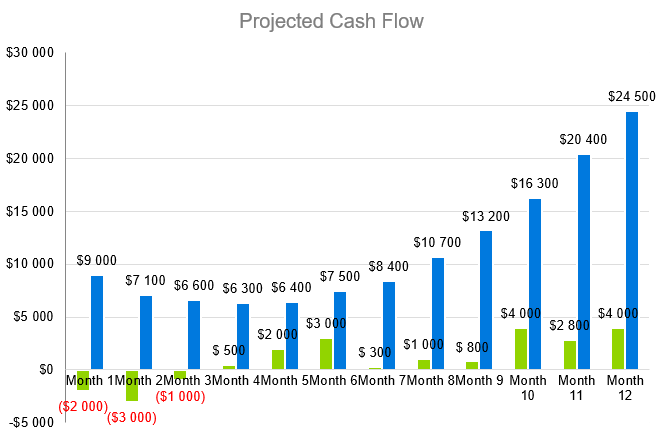
| Pro Forma Cash Flow | |||
| Cash Received | Year 1 | Year 2 | Year 3 |
| Cash from Operations | |||
| Cash Sales | $40,124 | $45,046 | $50,068 |
| Cash from Receivables | $7,023 | $8,610 | $9,297 |
| SUBTOTAL CASH FROM OPERATIONS | $47,143 | $53,651 | $59,359 |
| Additional Cash Received | |||
| Sales Tax, VAT, HST/GST Received | $0 | $0 | $0 |
| New Current Borrowing | $0 | $0 | $0 |
| New Other Liabilities (interest-free) | $0 | $0 | $0 |
| New Long-term Liabilities | $0 | $0 | $0 |
| Sales of Other Current Assets | $0 | $0 | $0 |
| Sales of Long-term Assets | $0 | $0 | $0 |
| New Investment Received | $0 | $0 | $0 |
| SUBTOTAL CASH RECEIVED | $47,143 | $53,651 | $55,359 |
| Expenditures | Year 1 | Year 2 | Year 3 |
| Expenditures from Operations | |||
| Cash Spending | $21,647 | $24,204 | $26,951 |
| Bill Payments | $13,539 | $15,385 | $170,631 |
| SUBTOTAL SPENT ON OPERATIONS | $35,296 | $39,549 | $43,582 |
| Additional Cash Spent | |||
| Sales Tax, VAT, HST/GST Paid Out | $0 | $0 | $0 |
| Principal Repayment of Current Borrowing | $0 | $0 | $0 |
| Other Liabilities Principal Repayment | $0 | $0 | $0 |
| Long-term Liabilities Principal Repayment | $0 | $0 | $0 |
| Purchase Other Current Assets | $0 | $0 | $0 |
| Purchase Long-term Assets | $0 | $0 | $0 |
| Dividends | $0 | $0 | $0 |
| SUBTOTAL CASH SPENT | $35,296 | $35,489 | $43,882 |
| Net Cash Flow | $11,551 | $13,167 | $15,683 |
| Cash Balance | $21,823 | $22,381 | $28,239 |
8.5 Projected Balance Sheet
| Pro Forma Balance Sheet | |||
| Assets | Year 1 | Year 2 | Year 3 |
| Current Assets | |||
| Cash | $184,666 | $218,525 | $252,384 |
| Accounts Receivable | $12,613 | $14,493 | $16,373 |
| Inventory | $2,980 | $3,450 | $3,920 |
| Other Current Assets | $1,000 | $1,000 | $1,000 |
| TOTAL CURRENT ASSETS | $201,259 | $237,468 | $273,677 |
| Long-term Assets | |||
| Long-term Assets | $10,000 | $10,000 | $10,000 |
| Accumulated Depreciation | $12,420 | $14,490 | $16,560 |
| TOTAL LONG-TERM ASSETS | $980 | $610 | $240 |
| TOTAL ASSETS | $198,839 | $232,978 | $267,117 |
| Liabilities and Capital | Year 1 | Year 2 | Year 3 |
| Current Liabilities | |||
| Accounts Payable | $9,482 | $10,792 | $12,102 |
| Current Borrowing | $0 | $0 | $0 |
| Other Current Liabilities | $0 | $0 | $0 |
| SUBTOTAL CURRENT LIABILITIES | $9,482 | $10,792 | $12,102 |
| Long-term Liabilities | $0 | $0 | $0 |
| TOTAL LIABILITIES | $9,482 | $10,792 | $12,102 |
| Paid-in Capital | $30,000 | $30,000 | $30,000 |
| Retained Earnings | $48,651 | $72,636 | $96,621 |
| Earnings | $100,709 | $119,555 | $138,401 |
| TOTAL CAPITAL | $189,360 | $222,190 | $255,020 |
| TOTAL LIABILITIES AND CAPITAL | $198,839 | $232,978 | $267,117 |
| Net Worth | $182,060 | $226,240 | $270,420 |
8.6 Business Ratios
| Ratio Analysis | ||||
| Year 1 | Year 2 | Year 3 | Industry Profile | |
| Sales Growth | 4.35% | 30.82% | 63.29% | 4.00% |
| Percent of Total Assets | 4.35% | 4.71% | 5.80% | 9.80% |
| Accounts Receivable | 5.61% | 4.71% | 3.81% | 9.70% |
| Inventory | 1.85% | 1.82% | 1.79% | 9.80% |
| Other Current Assets | 1.75% | 2.02% | 2.29% | 27.40% |
| Total Current Assets | 138.53% | 150.99% | 163.45% | 54.60% |
| Long-term Assets | -9.47% | -21.01% | -32.55% | 58.40% |
| TOTAL ASSETS | 100.00% | 100.00% | 100.00% | 100.00% |
| Current Liabilities | 4.68% | 3.04% | 2.76% | 27.30% |
| Long-term Liabilities | 0.00% | 0.00% | 0.00% | 25.80% |
| Total Liabilities | 4.68% | 3.04% | 2.76% | 54.10% |
| NET WORTH | 99.32% | 101.04% | 102.76% | 44.90% |
| Percent of Sales | ||||
| Sales | 100.00% | 100.00% | 100.00% | 100.00% |
| Gross Margin | 94.18% | 93.85% | 93.52% | 0.00% |
| Selling, General & Administrative Expenses | 74.29% | 71.83% | 69.37% | 65.20% |
| Advertising Expenses | 2.06% | 1.11% | 0.28% | 1.40% |
| Profit Before Interest and Taxes | 26.47% | 29.30% | 32.13% | 2.86% |
| Main Ratios | ||||
| Current | 25.86 | 29.39 | 32.92 | 1.63 |
| Quick | 25.4 | 28.88 | 32.36 | 0.84 |
| Total Debt to Total Assets | 2.68% | 1.04% | 0.76% | 67.10% |
| Pre-tax Return on Net Worth | 66.83% | 71.26% | 75.69% | 4.40% |
| Pre-tax Return on Assets | 64.88% | 69.75% | 74.62% | 9.00% |
| Additional Ratios | Year 1 | Year 2 | Year 3 | |
| Net Profit Margin | 19.20% | 21.16% | 23.12% | N.A. |
| Return on Equity | 47.79% | 50.53% | 53.27% | N.A. |
| Activity Ratios | ||||
| Accounts Receivable Turnover | 4.56 | 4.56 | 4.56 | N.A. |
| Collection Days | 92 | 99 | 106 | N.A. |
| Inventory Turnover | 19.7 | 22.55 | 25.4 | N.A. |
| Accounts Payable Turnover | 14.17 | 14.67 | 15.17 | N.A. |
| Payment Days | 27 | 27 | 27 | N.A. |
| Total Asset Turnover | 1.84 | 1.55 | 1.26 | N.A. |
| Debt Ratios | ||||
| Debt to Net Worth | 0 | -0.02 | -0.04 | N.A. |
| Current Liab. to Liab. | 1 | 1 | 1 | N.A. |
| Liquidity Ratios | ||||
| Net Working Capital | $120,943 | $140,664 | $160,385 | N.A. |
| Interest Coverage | 0 | 0 | 0 | N.A. |
| Additional Ratios | ||||
| Assets to Sales | 0.45 | 0.48 | 0.51 | N.A. |
| Current Debt/Total Assets | 4% | 3% | 2% | N.A. |
| Acid Test | 23.66 | 27.01 | 30.36 | N.A. |
| Sales/Net Worth | 1.68 | 1.29 | 0.9 | N.A. |
| Dividend Payout | 0 | 0 | 0 | N.A. |
Download Gourmet Food Store Business Sample in pdf
OGScapital also specializes in writing business plans such as coffee roasting business plan, how to open sandwich shop, donut shop business plan, business plan for butcher shop, opening a coffee shop business, bubble tea shop business plan and many other business plans.




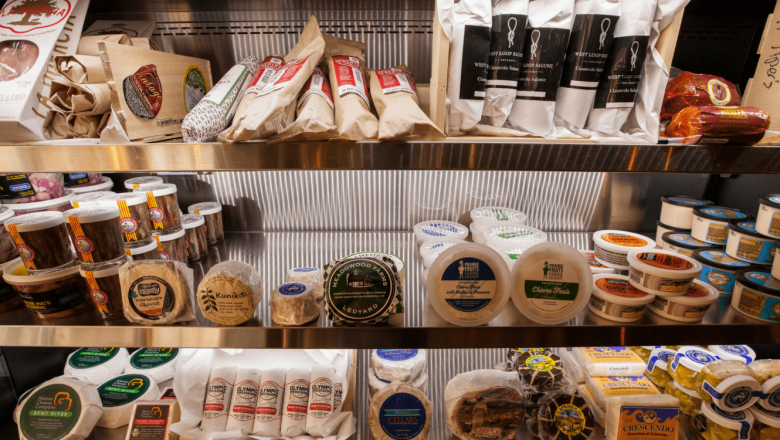





Add comment
Comments (0)